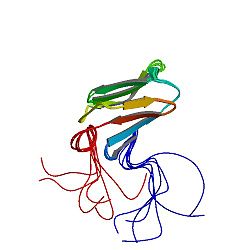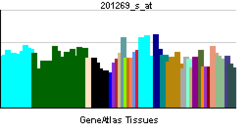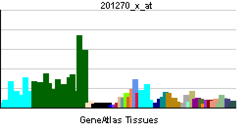- NUDCD3 (gene)
-
NudC domain containing 3 
PDB rendering based on 1wgv.Available structures PDB 1wgv Identifiers Symbols NUDCD3; KIAA1068; NudCL External IDs OMIM: 610296 MGI: 2144158 HomoloGene: 9097 GeneCards: NUDCD3 Gene Gene Ontology Molecular function • protein binding Sources: Amigo / QuickGO RNA expression pattern 

More reference expression data Orthologs Species Human Mouse Entrez 23386 209586 Ensembl ENSG00000015676 ENSMUSG00000053838 UniProt Q8IVD9 Q8R1N4 RefSeq (mRNA) NM_015332 NM_173748.4 RefSeq (protein) NP_056147 NP_776109.1 Location (UCSC) Chr 7:
44.42 – 44.53 MbChr 11:
6.01 – 6.1 MbPubMed search [1] [2] NudC domain-containing protein 3 is a protein that in humans is encoded by the NUDCD3 gene.[1]
The product of this gene functions to maintain the stability of dynein intermediate chain. Depletion of this gene product results in aggregation and degradation of dynein intermediate chain, mislocalization of the dynein complex from kinetochores, spindle microtubules, and spindle poles, and loss of gamma-tubulin from spindle poles. The protein localizes to the Golgi apparatus during interphase, and levels of the protein increase after the G1/S transition.[1]
References
Further reading
- "Toward a complete human genome sequence.". Genome Res. 8 (11): 1097–108. 1999. doi:10.1101/gr.8.11.1097. PMID 9847074.
- Kikuno R, Nagase T, Ishikawa K et al. (1999). "Prediction of the coding sequences of unidentified human genes. XIV. The complete sequences of 100 new cDNA clones from brain which code for large proteins in vitro". DNA Res. 6 (3): 197–205. doi:10.1093/dnares/6.3.197. PMID 10470851.
- Venter JC, Adams MD, Myers EW et al. (2001). "The sequence of the human genome". Science 291 (5507): 1304–51. doi:10.1126/science.1058040. PMID 11181995.
- Strausberg RL, Feingold EA, Grouse LH et al. (2003). "Generation and initial analysis of more than 15,000 full-length human and mouse cDNA sequences". Proc. Natl. Acad. Sci. U.S.A. 99 (26): 16899–903. doi:10.1073/pnas.242603899. PMC 139241. PMID 12477932. http://www.pubmedcentral.nih.gov/articlerender.fcgi?tool=pmcentrez&artid=139241.
- Scherer SW, Cheung J, MacDonald JR et al. (2003). "Human Chromosome 7: DNA Sequence and Biology". Science 300 (5620): 767–72. doi:10.1126/science.1083423. PMC 2882961. PMID 12690205. http://www.pubmedcentral.nih.gov/articlerender.fcgi?tool=pmcentrez&artid=2882961.
- Hillier LW, Fulton RS, Fulton LA et al. (2003). "The DNA sequence of human chromosome 7". Nature 424 (6945): 157–64. doi:10.1038/nature01782. PMID 12853948.
- Ota T, Suzuki Y, Nishikawa T et al. (2004). "Complete sequencing and characterization of 21,243 full-length human cDNAs". Nat. Genet. 36 (1): 40–5. doi:10.1038/ng1285. PMID 14702039.
- Brandenberger R, Wei H, Zhang S et al. (2005). "Transcriptome characterization elucidates signaling networks that control human ES cell growth and differentiation". Nat. Biotechnol. 22 (6): 707–16. doi:10.1038/nbt971. PMID 15146197.
- Gerhard DS, Wagner L, Feingold EA et al. (2004). "The Status, Quality, and Expansion of the NIH Full-Length cDNA Project: The Mammalian Gene Collection (MGC)". Genome Res. 14 (10B): 2121–7. doi:10.1101/gr.2596504. PMC 528928. PMID 15489334. http://www.pubmedcentral.nih.gov/articlerender.fcgi?tool=pmcentrez&artid=528928.
- Rual JF, Venkatesan K, Hao T et al. (2005). "Towards a proteome-scale map of the human protein-protein interaction network". Nature 437 (7062): 1173–8. doi:10.1038/nature04209. PMID 16189514.
- Zhou T, Zimmerman W, Liu X, Erikson RL (2006). "A mammalian NudC-like protein essential for dynein stability and cell viability". Proc. Natl. Acad. Sci. U.S.A. 103 (24): 9039–44. doi:10.1073/pnas.0602916103. PMC 1482562. PMID 16754861. http://www.pubmedcentral.nih.gov/articlerender.fcgi?tool=pmcentrez&artid=1482562.
PDB gallery Categories:- Human proteins
- Chromosome 7 gene stubs
Wikimedia Foundation. 2010.

